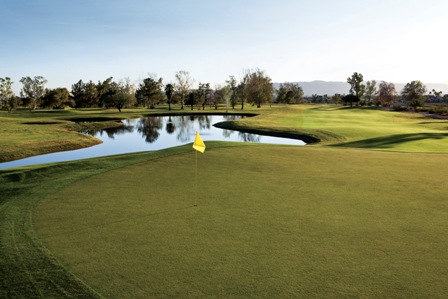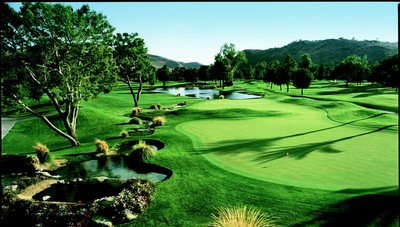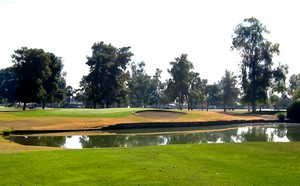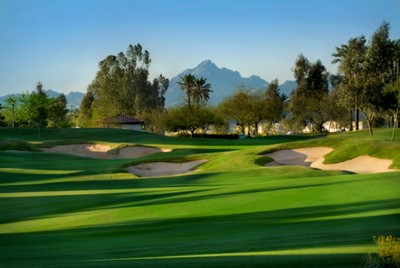Arizona Golf Authority Golf Course Buzz: People haven’t stopped buzzing about Papago Golf Course – the finest municipal golf course in Phoenix – ever since it underwent a redesign in 2008. The “Buzz” is Papago remains No. 1 among Phoenix’s five “munis’’ simply because the design was too outstanding and the nearby Buttes of the same name are a creation to behold.

Built in the late 1960s by noted architect William F. Bell, whose resume includes Torrey Pines near San Diego, Papago was the site of the 1971 U.S. Public Links Championship, and at one time was the course where all the best players in Arizona brought there game.
One of those was Billy Mayfair, who grew up at Papago along with his junior “sidekick,’’ the late Heather Farr. Another, the legendary Johnny Bulla, still holds the course record with an 11-under-par 61, a score he shot, unbelievably, swinging both right-handed and left-handed. The only wild card at Papago is the course conditioning, which has waned since the renovation even though it was in top shape when it hosted the LPGA’s International Tournament in 2009.
But, as Mayfair noted: “It’s such a great golf course, even when it’s in lousy shape, you can still see the beauty in it.”
Be ready to play from the start, the first three holes are a thorough examination of your game. And unless you’re scratch, stay away from the 7,333-yard black tee markers, we’re using 6,771-yard blue tee marker yardages here.
The 544-yard 5-par opener sweeps left to right, the green is elevated above eye level and pitches from left to right towards a pond. Whether attacking it with a long second shot, or a short iron third, anything deep or right of green-center is gravity-drawn to that water. The amateur-play is to select a club for center of the green yardage and let the elevation change leave you in the front 1/3 of the green; it’s more fun than starting with the dreaded “double”.
The 350-yard second asks you to bend your tee shot the other way, right to left, and the downhill fairway makes it play like the classic “short par-4” that finds it’s way into every current golf course design; this one’s been here over 50 years. Any club, from driver to 6-iron, off the tee will do, the second shot is uphill to a heavily contoured green that features the Papago Butte rock formations as a backdrop. The green undulations, the striking Buttes, or both produce a lot of 3-putts here.
The third at Papago is as demanding a golf hole as you’ll find in Arizona, bar none. Standing on the tee, however, it doesn’t let you know that. What you see is a straight-away, slightly downhill 438-yard par-4 with a high-right to down-left swale in the tee shot landing area; native desert hugs both sides of the fairway. Be advised, when the tee ball lands, it’s going to run left, a lot, and there’s desert over there. Start it too far right though, and the swale kills the tee-ball’s momentum, kicking it right toward the desert on that side. You’ll have to mold yourself into the hillside for your second as there are no level lies in this fairway. An enormous, well bunkered and severely undulated green complex completes this test. Bogey here is fine for amateurs, the occasional par is thrilling.
Three of Papago’s 3-par’s ask for 200-yard clubs, the fourth, number 11, is a mid-iron carry over water.
The strong finisher, 441-yard left to right par-4 at Papago makes the whole day worthwhile, especially late in the day when the sun, low in the western sky, paints the Papago Buttes backdrop with reds, purples, pinks and oranges you’ve never seen on any mortal-artist’s palette. The tee shot needs to carry the crest of the hill for some roll out, and the second must be carved into a mid-sized green sloping from right to left toward sand bunkers and desert.
Papago’s practice facilities are generous, all turf and artfully situated adjacent to the Buttes; even the poor shots look a little better against that elegant backdrop. Although a new clubhouse is planned, check-in and so forth is currently handled in temporary pre-fabricated facilities, which work just fine. Papago has also installed a monitoring system for the golf cart fleet that prevents the carts from being driven into the desert, thereby protecting the natural setting and wildlife residing therein.
Although you may not find the manicured course conditioning featured on the elegant tracks in North Scottsdale at Papago, you will find a first-rate test of golf in a lovely natural setting where well played shots are rewarded, and against that backdrop. even the lousy ones will look a little better.
AZGA Arizona Golf “Local Hang” for Papago includes the Tee Pee Tap Room, just west of 44th Street on Indian School Road in Phoenix and, Duke’s in Scottsdale, south side of McDowell Road, just east of 76th Street.
![]() Click golfmix.com to read what other local players have posted about playing Papago.
Click golfmix.com to read what other local players have posted about playing Papago.
Read the Arizona Golf Course Directory AZGA Buzz for every golf course in Arizona at www.arizonagolfauthority.com/coursedirectory/; it’s “All Things Arizona Golf” from the Arizona Golf Authority.







